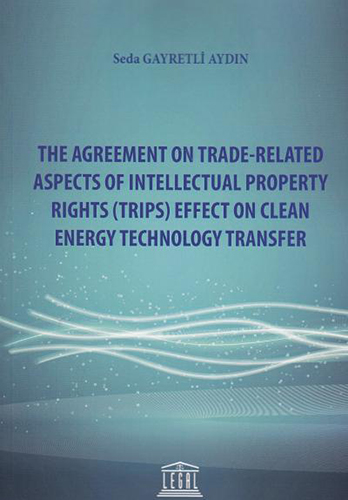
Bu çalışma, fikri mülkiyet hukuku, teknoloji transferi ve iklim değişikliği arasındaki kesişime odaklanmaktadır. Bu çalışmanın amacı fikri mülkiyet haklarını çevresel haklarla dengelemektir. Kitap, TRIPS, UNFCCC ve WIPO’nun 2007 Kalkınma Gündemi, fikri mülkiyet ve iklim değişikliği ile ilgili uluslararası kuralları içermekte olup, ağırlıklı olarak TRIPS üzerinde yoğunlaşmıştır.
TABLE OF CONTENTS
TABLE OF CONTENTS III
DEDICATION IX
PREFACE XI
ABBREVIATIONS XV
CHAPTER I
INTRODUCTION 1
1.1 Background 1
CHAPTER II
CLIMATE CHANGE BATTLE
2.1. INTRODUCTION 13
2.2. CLIMATE CHANGE 13
2.2.1. CAUSES OF CLIMATE CHANGE 15
2.2.2. CURRENT IMPACTS OF CLIMATE CHANGE 19
1. Weather and Climate ( Extreme Weather Events ) 19
2. Oceans (Sea Levels Rise and Coastal Impacts) 20
3. Snow and ice 21
4. Society and Ecosystem (Wildlife and Endangered Species) 22
5. Human Health 22
2.2.3. Future Impacts of Climate Change 23
2.3. CLIMATE CHANGE AGREEMENTS AND CONFERENCES 24
2.3.1. Background Information 24
2.3.2. World Meteorological Organization WMO (First World Climate Conference) 25
2.3.3. Montreal Protocol on Substances that Deplete the Ozone Layer 1987 26
2.3.4. Intergovernmental Panel on Climate Change 1988 27
2.3.5. Nations Framework Convention on Climate Change 1992 28
1. Kyoto Protocol 1997 30
2. Bali Action Plan 2007 32
3. Cancun Agreements 32
4. Durban Platform 33
5. Doha Climate Gateway 34
6. Warsaw Outcomes 34
7. The Universal Climate Change Treaty - Paris Agreement 35
2.4 CLIMATE CHANGE POLICIES OF WTO MEMBERS 36
2.4.1 The United States 36
2.4.2 The European Union 38
2.4.3. China 39
2.4.4. Turkey 41
CHAPTER III
TRANSFER OF CLEAN TECHNOLOGY
3.1. INTRODUCTION 45
3.2. CLEAN ENERGY 45
3.2.1 Background Information 45
3.2.2 Fossil Fuels 46
3.2.3. Nuclear Energy 48
3.2.4. Renewable Energy Sources 48
1. Solar Energy 49
2. Wind Energy 51
3. Geothermal Energy 52
4. Biomass Energy 52
5. Hydropower 53
3.3 RENEWABLE ENERGY AS A SOLUTION TO CLIMATE CHANGE BATTLE 54
3.3.1. Energy conservation and efficiency 54
3.3.2. Carbon capture storage and trade, and carbon tax 55
3.3.3. Renewable energy 56
3.4. TRANSFER OF CLEAN ENERGY TECHNOLOGY AND INTERNATIONAL LAW 57
3.4.1 CLEAN ENERGY TECHNOLOGY 59
1. Definition of Technology 59
2. History and Definition of Transfer of Technology 60
3.4.2 INTERNATIONAL LAW OF CLEAN TECHNOLOGY TRANSFER 63
1. UNCTAD’s Draft of International Code of Technology Transfer 63
2. Montreal Protocol on Substances that Deplete the Ozone Layer 1987 64
3. United Nations Framework Convention on Climate Change 65
4. KYOTO PROTOCOL 66
5. BALI ACTION PLAN 67
6. COPENHAGEN ACCORD 69
7. CANCUN AGREEMENTS 72
8. DURBAN PLATFORM FOR ENHANCED ACTION 73
9. DOHA CLIMATE GATEWAY 74
10. INTERNATIONAL CLIMATE CHANGE AGREEMENT – PARIS AGREEMENT 74
3.5. CONCLUSION 75
CHAPTER IV
INTERNATIONAL INTELLECTUAL PROPERTY AND TECHNOLOGY TRANSFER
4.1. INTRODUCTION 77
4.2. INTERNATIONAL INTELLECTUAL PROPERTY 78
4.2.1 Intellectual Property 78
4.2.2 Backgrounds of International Intellectual Property Law 79
4.3 WORLD INTELLECTUAL PROPERTY ORGANIZATION 82
4.3.1 CORE ACTIVITIES OF WIPO 83
4.3.2 The WIPO and TRANSFER of TECHNOLOGY 85
1) WIPO’s Development Agenda 86
2) WIPO’s technology databases (WIPO Gold) 91
a. Technology Databases (Patentscope) 92
b. Laws and Treaties (WIPO Lex ) 93
3) WIPO’s Technology Innovation and Support Centers (TISCs) 94
4) WIPO’s Sustainable Technology Marketplace (WIPO Green) 95
5) WIPO’s Patent landscapes reports 97
6) WIPO’s Technology Transfer Reports 98
7) WIPO - WTO Joint Workshops and WIPO’s seminars related to TRIPS Agreement 100
8) WIPO’s Technology Transfer Seminars 104
CHAPTER V
THE WORLD TRADE ORGANIZATION AND THE TRADE-RELATED ASPECTS OF INTELLECTUAL PROPERTY RIGHTS (TRIPS) AGREEMENT
5.1 INTRODUCTION 109
5.2. BACKGROUNDS OF THE TRIPS AGREEMENT 110
5.2.1. PLACE OF THE TRIPS AGREEMENT WITHIN THE WORLD TRADE ORGANIZATION 112
5.2.2. THE TRIPS AGREEMENT’S ADVANTAGES FOR DEVELOPING COUNTRIES AND THE LEAST DEVELOPED COUNTRIES. 114
1) Technology Transfer 115
2) Incentives and Enterprises 115
3) Technical Corporation 118
4) Transitional Periods 119
5.2.3. OUTLINE OF THE TRIPS AGREEMENT 120
5.2.4. GENERAL PROVISIONS AND BASIC PRINCIPLES of THE TRIPS AGREEMENT 123
1) Minimum Standard Agreement ( Article 1: Nature and Scope of Obligations) 124
2) Intellectual Property Protection (Article 2) 126
3) National treatment (Article 3) 127
4) Most Favored Nation Treatment (Article 4) 128
5) Multilateral Agreements on Acquisition or Maintenance of Protection (Article 5) 129
6) Exhaustion (Article 6) 130
7) Objectives (Article 7) 131
8) Principles (Article 8) 132
5.2.5. IMPLEMENTATION OF THE TRIPS AGREEMENT 132
5.2.6. HOW the TRIPS AGREEMENT IS DIFFERENT THAN WIPO GOVERNED INTERNATIONAL INTELLECTUAL PROPERTY AGREEMENTS 134
CHAPTER VI
THE TRIPS AGREEMENT’S TECHNOLOGY TRANSFER RELATED ARTICLES
6.1. Introduction 137
6.2. Preamble of the WTO Agreement 137
6.3. Preamble of the TRIPS Agreement 140
6.4. Objectives (Article 7) 144
6.5. Principles (Article 8) 147
6.6. Patentable subject matter (Article 27) 150
6.7. Exceptions to Rights Conferred (Article 30) 156
6.7.1. Experimental Use and Research 157
6.7.2. Bolar – Early Working Exception 158
6.8. Parallel Imports 160
6.9. Compulsory Licensing (Article 31) 161
6.10 Control of Anti- Competitive Practices in Contractual Licenses (Article 40) 165
6.11. Technology Transfer Mechanism (Article 66) 167
6.12. Security Exceptions (Article 73) 169
6.13 Other Articles may be used to facilitate clean technology transfer 171
CHAPTER VII
CONCLUSION AND SUGGESTIONS
7.1. SUMMARY 173
7.2 ADVANTAGES OF THE TRIPS AGREEMENT 180
7.3. DISADVANTAGES OF THE TRIPS AGREEMENT 182
7.4. ALTERNATIVE SOLUTIONS TO TECHNOLOGY TRANSFER 185
7.4.1. Patent Pools 185
7.4.2. Clean Technology Awards 186
7.4.3. The Eco-Patent Commons 187
7.4.4. Carbon and Trade Market & Creative Common Licenses joint model 188
7.5. SUGGESTIONS 188
7.6. CONCLUSION 189
BIBLIOGRAPHY 193